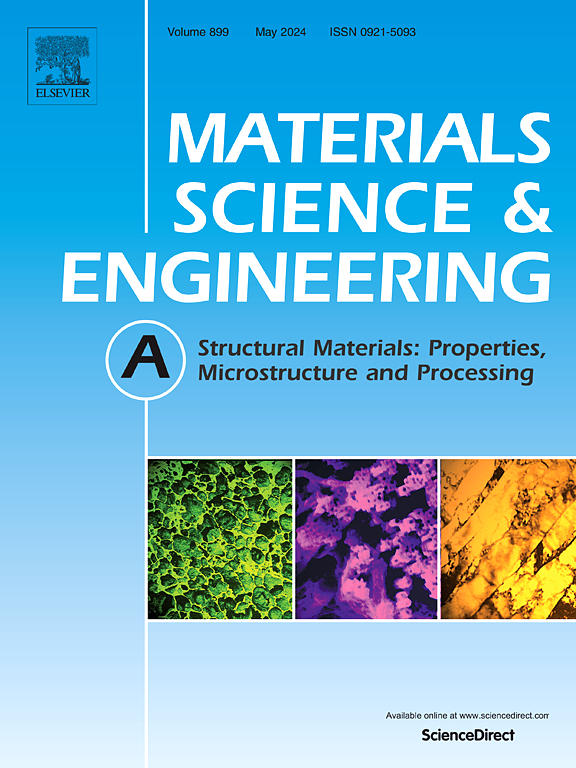Observation of interface disruption and Lomer-Cottrell locks in a crept L12-strengthened Ni-based superalloy
IF 6.1
2区 材料科学
Q1 MATERIALS SCIENCE, MULTIDISCIPLINARY
引用次数: 0
Abstract
High-temperature, creep-resistant Ni-based superalloys used in turbine blades for aviation and power generation offer a potential route toward global energy savings. However, the fundamental mechanisms governing their long-term creep failure remain insufficiently understood. In this study, we propose a compositionally modified Ni-based polycrystalline Inconel 738LC alloy by reducing Co and increasing Al content. This modification enhances the yield strength from 844 to 924 MPa and significantly improves creep resistance at 750 °C under 600 MPa compared to the conventional Inconel 738LC series. We investigated the creep deformation mechanisms by analyzing microstructural evolution—particularly at the γ/γ′ interfaces—using transmission electron microscopy (TEM) and atom probe tomography (APT). The results reveal that creep deformation generates stress concentration at the corners of cuboidal γ′ precipitates, leading to interfacial disruption and the formation of abundant Lomer–Cottrell (LC) locks. These features contribute to both localized softening and overall hardening effects. Further TEM dark-field imaging under two-beam conditions demonstrates that during the later stages of creep, LC dislocations are also formed along solute-segregated planar faults within the γ′ precipitates. These dislocations result from the cross-slip of superpartial dislocations along the γ′ planar faults, from octahedral {111} planes to cubic {001} planes. Even though numerous twins and stacking faults (SFs) are additionally seen in the current alloy upon creep, the presence of LC-locking sessile dislocations—formed at both the γ′/γ interfaces and along solute-rich planar faults within the γ′ precipitates—emerged as a key feature contributing to the enhanced creep resistance. Their formation hinders dislocation motion and stabilizes the microstructure under prolonged thermal stress. Consequently, these γ′-LC dislocations and the associated interface-disrupted configurations collectively improve creep strength and extend rupture life. This study offers valuable insights into LC locks-mediated creep mechanisms, highlighting a promising pathway for the design of next-generation Ni-based superalloys.
蠕变l12强化镍基高温合金界面破坏和lmer - cottrell锁的观察
高温、耐蠕变的镍基高温合金用于航空和发电涡轮叶片,为全球节能提供了一条潜在的途径。然而,控制其长期蠕变破坏的基本机制仍然没有得到充分的了解。在本研究中,我们提出了一种通过降低Co含量和增加Al含量来改性镍基多晶Inconel 738LC合金。与传统的Inconel 738LC系列相比,该改性将屈服强度从844提高到924 MPa,并显着提高了600 MPa下750°C的抗蠕变性能。我们利用透射电子显微镜(TEM)和原子探针断层扫描(APT)分析微观结构演变,特别是在γ/γ′界面,研究了蠕变变形机制。结果表明,蠕变变形在立方γ′析出相的四角处产生应力集中,导致界面破坏,形成丰富的lomo - cottrell (LC)锁;这些特征有助于局部软化和整体硬化效果。进一步的双光束条件下的TEM暗场成像表明,在蠕变的后期阶段,LC位错也沿着γ′析出相中的溶质偏析平面断层形成。这些位错是由a6[11 - 2]、a6[11 - 0]、a6[112 - 1]沿γ′平面断层的交叉滑移引起的,从八面体{111}平面到立方{001}平面。尽管目前的合金在蠕变过程中还存在许多孪晶和层错(sf),但在γ′/γ界面和γ′析出物中富含溶质的平面断层上形成的lc -锁固位错的存在是增强抗蠕变性能的一个关键特征。它们的形成阻碍了位错的运动,稳定了长时间热应力下的微观组织。因此,这些γ′-LC位错和相关的界面破坏构型共同提高了蠕变强度,延长了断裂寿命。这项研究为LC锁介导的蠕变机制提供了有价值的见解,为下一代ni基高温合金的设计提供了一条有前途的途径。
本文章由计算机程序翻译,如有差异,请以英文原文为准。
求助全文
约1分钟内获得全文
求助全文
来源期刊

Materials Science and Engineering: A
工程技术-材料科学:综合
CiteScore
11.50
自引率
15.60%
发文量
1811
审稿时长
31 days
期刊介绍:
Materials Science and Engineering A provides an international medium for the publication of theoretical and experimental studies related to the load-bearing capacity of materials as influenced by their basic properties, processing history, microstructure and operating environment. Appropriate submissions to Materials Science and Engineering A should include scientific and/or engineering factors which affect the microstructure - strength relationships of materials and report the changes to mechanical behavior.
 求助内容:
求助内容: 应助结果提醒方式:
应助结果提醒方式:


